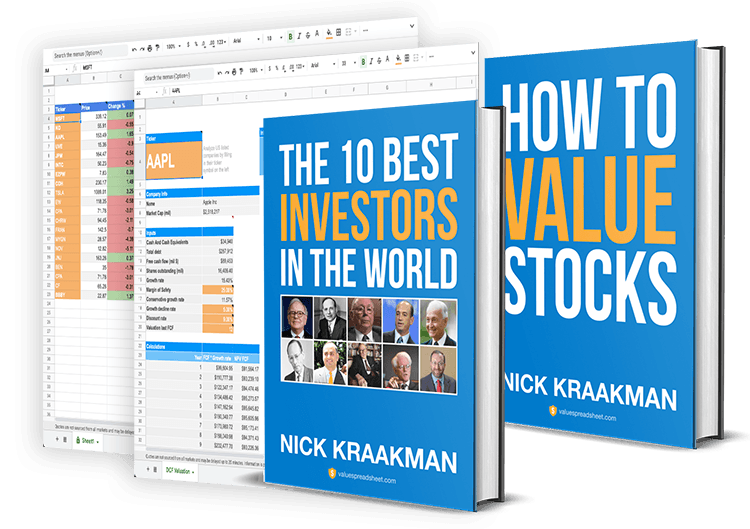Transcript
Hello, everyone, and welcome to the very first ever episode of the Value Investing Bootcamp podcast.
I'm very excited to be here with you today and that you decided to plug me into your ears.
I'm your host, Nick Kraakman, and today I have a very interesting story for you, or at least, I find it interesting because it's about myself haha.
It's how I started with investing and the things I learned along the way, and I think you can take these lessons and avoid some of the mistakes that I made in the beginning.
But before we get into that, I want to thank everyone that already indicated they're interested in my upcoming value investing bootcamp video course, which I plan to release the end of June [It's been released by now :-)].
I mean, this interest really motivates me to give it my best.
The story of how I started investing and what I learned along the way, it really started about 10 years ago.
I was sitting in middle school next to a good friend of mine, and his father had a bit of money and was already investing, and it just seemed like such an amazing thing that you can have some money, invest it in something and then get more money out after a while.
It just seemed so magical to me, so I thought, hmm, let's do this.
So, I looked up on the internet how to start investing in stocks, and I found out all I needed is a brokerage account, so I decided to open one.
However, the thing was, I was only 14 years old. So, I had to-- Oh, yeah, the company asked me to let my parents sign a form, which told them that they approve of me wasting my money on the stock market.
So, I gave this form to my parents, and they signed it without hesitation.
I mean, I'm still grateful for that, but it just seems a bit strange.
They didn't seem to think about it that long.
But in the end, it all turned out just fine.
However, in the beginning, I had no clue what I was doing.
I opened a brokerage account, I logged in, I saw all these stocks moving up and down all the time, I had literally no idea what I was doing.
My strategy back then was to just have a look at the list of available stocks until I found a name of a company that I actually recognized.
So, I thought, ah, yeah, I know this one, let's put all my savings into this one without any further analysis whatsoever.
This went well.
Of course, I just had pure luck.
It went well for a very short while.
But for example, I made, let's say 10% in a couple of months, which was pretty impressive I thought.
But then I realized that I only had a very small amount of money invested because remember, I was only 14 years old.
So, I had 10% profit, but when I sold, the transaction costs literally demolished or eradicated all the returns that I made.
By the way, guys, I am from the Netherlands, Amsterdam, that's why my English might not always be flawless, so bear with me on that.
So, yeah, I picked stocks and earned some money, sold them and then transaction costs just vanquished all my profits.
So, I actually sent an email to my brokerage firm telling them like, what is this? This is ridiculous!
Why are you charging such high transaction costs, I don't have any profits left after paying them.
And of course, they sent me an email that I should read a bit more.
And I thought, well, the only other option I came across was options.
Actually, the other option was options, and turbos and speeders and all kinds of leverage products.
I thought, well, they allow me to earn a lot of money while not having to invest more money.
I mean, even with a small investment, relatively small investment, you can earn quite reasonable sums of money if you have enough leverage.
Of course, I didn't realize that this leverage also works the other way around.
Leverage can allow you to earn 10% when the stock just changes 1%, but it also works the other way.
So, if the stock loses 1% of its price, your leveraged product, your investment goes down by 10%.
This way, I pretty quickly, I guess in two weeks time, I managed to lose half of my savings, actually, half of my savings back then, which was a really big deal to me.
I think I started crying if I remember.
And I actually sent an email to one of the newsletters I was following and just asking the guy like, what happened? Does this happen to everyone or is it just me?
He told me just see it as learning money, you know, that money, you've lost, you just paid for your investment education, so to say.
Well at that point, I of course hated this guy, I thought is this the best advice you can give me, but actually, in hindsight, it was good advice.
So, I started thinking: how do people who are actually earning money on the stock market do it? How do they make money? How do they make their decisions?
That is when I really started to look into the strategies of the best in the world, and of course the first person I stumbled upon was Warren Buffett and his value investing approach.
So, I started reading books, I joined some newsletters, I got a free ebook somewhere, which explained his strategy in detail.
This really got me started and it just all seemed so logical: buying good companies at discount prices.
I mean, it's just such a logical strategy, and it made complete sense straight away, so I started applying the strategy, and it actually worked!
I started making consistent returns.
I also by that time had some spreadsheets, I created them myself, some I downloaded, just to speed up calculations of financial ratios, and intrinsic value.
We'll talk about many of these concepts in later podcast episodes, but you know, I just created spreadsheets to speed up calculations.
However, at some point I had so many spreadsheets, and I had to input the same data into all of them, I made some errors while inputting the data, it just was a mess and it took a lot of time.
So, I decided to combine all those spreadsheets into one, and then I found out about Google documents, which actually allows you to create spreadsheets similar to excel.
However, they also had a functionality which allows you to draw in data from websites, also financial data.
So, what I did with this combined spreadsheet, this one spreadsheet to rule them all, so to say, I added this functionality to draw in financial data from my online sources.
This way, I managed to fully automate the spreadsheet, which reduced the time to analyze a stock from hours to seconds, literally.
I used this tool successfully for a couple of years, and then I read The 4-Hour Workweek by Tim Ferriss, which really inspired me to set up an online business.
That is actually when I started ValueSpreadsheet.com, which is a place where I teach others about value investing through blogging, and where I offer some free spreadsheets as well as the premium spreadsheet I just talked about.
That was it for today.
That was the story of how I got started.
At this moment, I'm working on this value investing video course.
It will literally cover all the information that I have, all the knowledge that I have about value investing will be in there.
It will be a course for beginners, but it will also cover advanced topics.
It will really allow you to manage your own portfolio and pick winning stocks.
And yeah, it will be launched at the end of June. So, thank you for listening to this episode, this very first episode of this limited edition podcast series. And I hope to see you in the next episode. Thanks. Have a good day.
If you enjoyed today's show, head over to ValueInvestingBootcamp.com to find out more on how you can invest like the pros, manage your own portfolio with confidence, and consistently earn mind boggling returns on the stock market.



